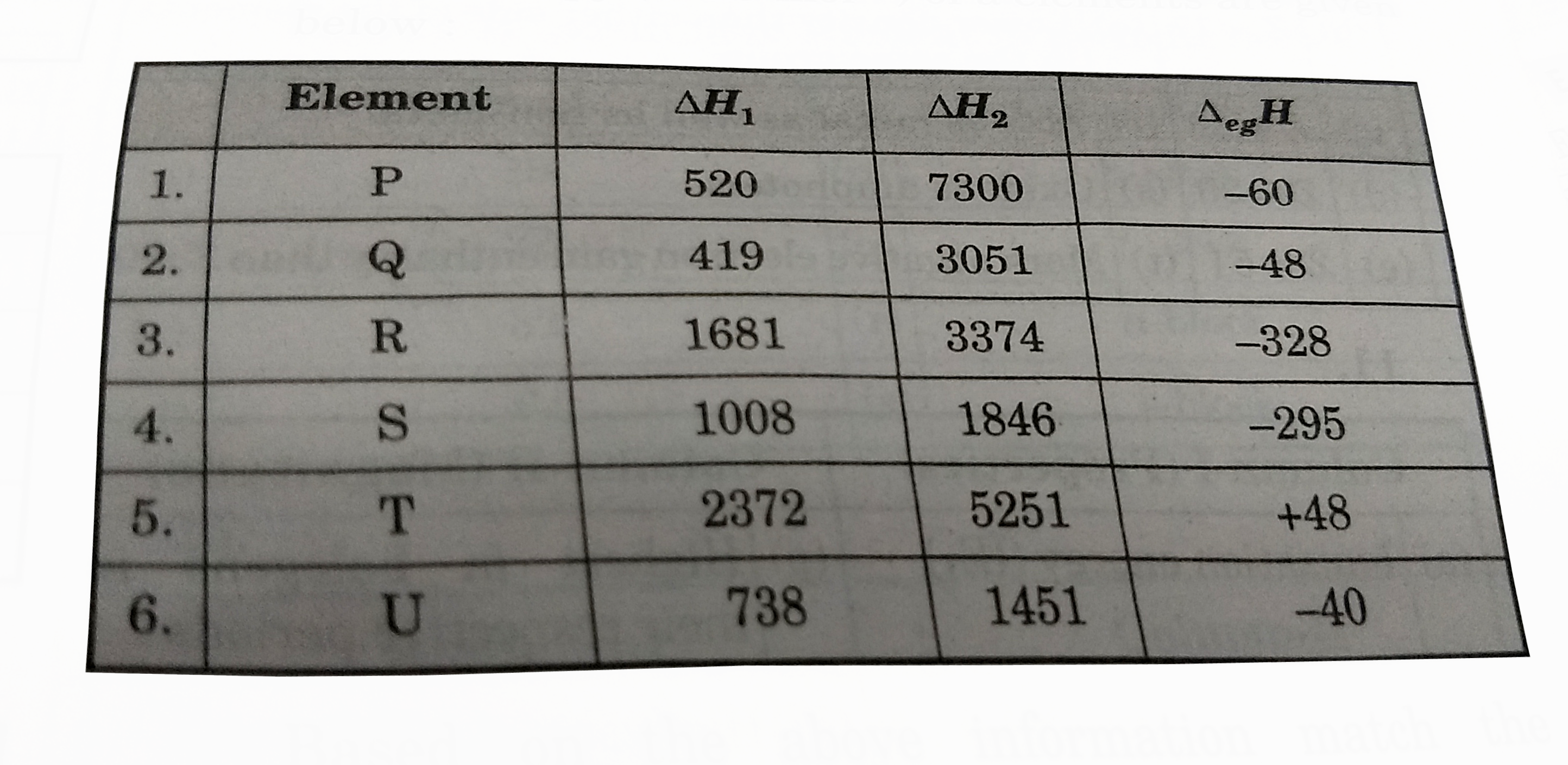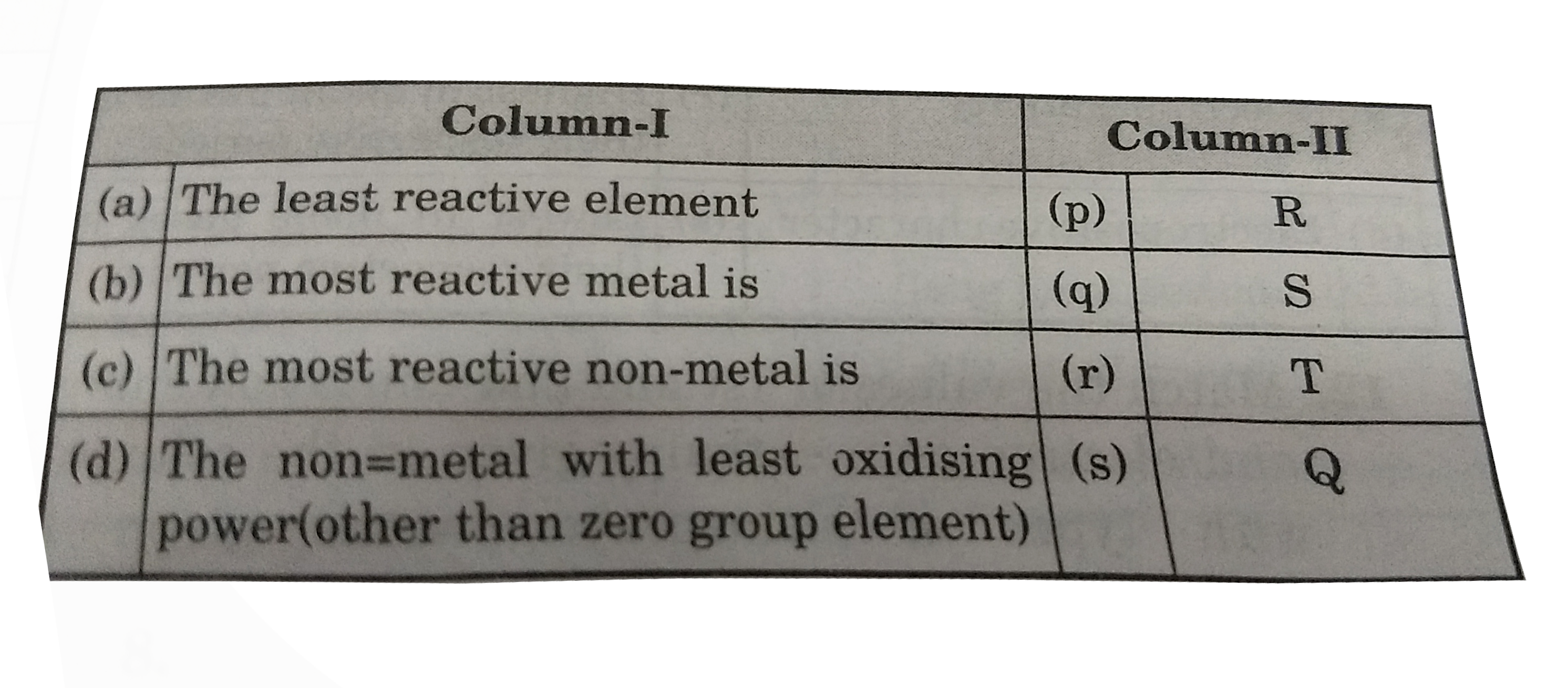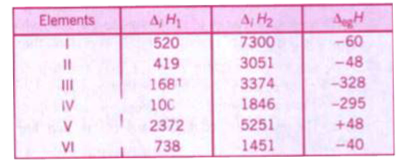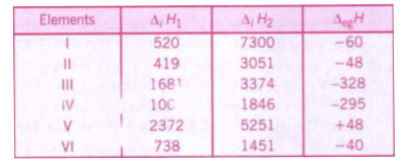The first (ΔiH1 and second (ΔiH2 ionization enthalpies (in kJ/mol) and electron gain enthalpy (in kJ/mol) of few elements are given below:
ElementsΔiH1ΔiH2ΔegHI5207300−60II16813374−328III8991757−48IV23725251+48
Which of the following is likely to be an alkali metal?
(a) I and IV
(b) IV and III
(c) II and IV
(d) I and III
The correct Answer is:C
To determine which of the given elements is likely to be an alkali metal based on their ionization enthalpies and electron gain enthalpy, we can follow these steps:
1. Understand Ionization Enthalpy and Electron Gain Enthalpy:
- Ionization Enthalpy: The energy required to remove an electron from an atom. Alkali metals have low first ionization enthalpy because they can easily lose their single valence electron.
- Electron Gain Enthalpy: The energy change when an electron is added to an atom. Alkali metals typically have a negative electron gain enthalpy, indicating they do not favor gaining electrons.
2. Analyze the Given Data:
- The data provided is:
- Element I: ΔiH1=520kJ/mol,ΔiH2=7300kJ/mol,ΔegH=−60kJ/mol
- Element II: ΔiH1=1681kJ/mol,ΔiH2=3374kJ/mol,ΔegH=−328kJ/mol
- Element III: ΔiH1=899kJ/mol,ΔiH2=1757kJ/mol,ΔegH=−48kJ/mol
- Element IV: ΔiH1=2372kJ/mol,ΔiH2=5251kJ/mol,ΔegH=+48kJ/mol
3. Identify Low First Ionization Enthalpy:
- Alkali metals have low first ionization enthalpy. From the data:
- Element I: 520 kJ/mol (low)
- Element II: 1681 kJ/mol (high)
- Element III: 899 kJ/mol (moderate)
- Element IV: 2372 kJ/mol (very high)
- The lowest values are for Element I and Element III.
4. Identify Negative Electron Gain Enthalpy:
- Alkali metals typically have negative electron gain enthalpy. From the data:
- Element I: -60 kJ/mol (negative)
- Element II: -328 kJ/mol (negative)
- Element III: -48 kJ/mol (negative)
- Element IV: +48 kJ/mol (positive)
- Elements I, II, and III have negative values, but Element IV has a positive value, indicating it is not likely to be an alkali metal.
5. Conclusion:
- Based on the low first ionization enthalpy and negative electron gain enthalpy, Elements I and III are potential candidates for being alkali metals. However, Element I has the lowest first ionization enthalpy and a negative electron gain enthalpy, making it the most likely candidate.
- Therefore, the correct answer is Option D: Element I and Element III.
- Ionization Enthalpy: The energy required to remove an electron from an atom. Alkali metals have low first ionization enthalpy because they can easily lose their single valence electron.
- Electron Gain Enthalpy: The energy change when an electron is added to an atom. Alkali metals typically have a negative electron gain enthalpy, indicating they do not favor gaining electrons.
- The data provided is:
- Element I: ΔiH1=520kJ/mol,ΔiH2=7300kJ/mol,ΔegH=−60kJ/mol
- Element II: ΔiH1=1681kJ/mol,ΔiH2=3374kJ/mol,ΔegH=−328kJ/mol
- Element III: ΔiH1=899kJ/mol,ΔiH2=1757kJ/mol,ΔegH=−48kJ/mol
- Element IV: ΔiH1=2372kJ/mol,ΔiH2=5251kJ/mol,ΔegH=+48kJ/mol
- Alkali metals have low first ionization enthalpy. From the data:
- Element I: 520 kJ/mol (low)
- Element II: 1681 kJ/mol (high)
- Element III: 899 kJ/mol (moderate)
- Element IV: 2372 kJ/mol (very high)
- The lowest values are for Element I and Element III.
- Alkali metals typically have negative electron gain enthalpy. From the data:
- Element I: -60 kJ/mol (negative)
- Element II: -328 kJ/mol (negative)
- Element III: -48 kJ/mol (negative)
- Element IV: +48 kJ/mol (positive)
- Elements I, II, and III have negative values, but Element IV has a positive value, indicating it is not likely to be an alkali metal.
- Based on the low first ionization enthalpy and negative electron gain enthalpy, Elements I and III are potential candidates for being alkali metals. However, Element I has the lowest first ionization enthalpy and a negative electron gain enthalpy, making it the most likely candidate.
- Therefore, the correct answer is Option D: Element I and Element III.
Topper's Solved these Questions
- CLASSIFICATION OF ELEMENTS AND PERIODICITY Book:NCERT FINGERTPS ENGLISHChapter:CLASSIFICATION OF ELEMENTS AND PERIODICITY Exercise:EXEMPLAR PROBLEMS
Explore 12 Videos
- CLASSIFICATION OF ELEMENTS AND PERIODICITY Book:NCERT FINGERTPS ENGLISHChapter:CLASSIFICATION OF ELEMENTS AND PERIODICITY Exercise:ASSERTION & REASON
Explore 15 Videos
- CLASSIFICATION OF ELEMENTS AND PERIODICITY Book:NCERT FINGERTPS ENGLISHChapter:CLASSIFICATION OF ELEMENTS AND PERIODICITY Exercise:Assertion And Reason
Explore 15 Videos
- CHEMICAL BONDING & MOLECULAR STRUCTUREBook:NCERT FINGERTPS ENGLISHChapter:CHEMICAL BONDING & MOLECULAR STRUCTUREExercise:Assertion And Reason
Explore 15 Videos
- ENVIRONMENTAL CHEMISTRYBook:NCERT FINGERTPS ENGLISHChapter:ENVIRONMENTAL CHEMISTRYExercise:Assertion And Reason
Explore 15 Videos
Similar Questions
The first (ΔiH1) and second (ΔiH2) ionisation enthalpies (inkJmol−1) and the (ΔegHө) electron gain enthalpy (inkJmol−1) of a few elements are given below:
Elements(ΔiH1)(ΔiH2)ΔegHөI5207300−60II4193051−48III16813374−328IV10081846−295V23725251+48VI7381451−40
Which of the above elements is likely to be
a. the least reactive element.
b. the most reactive metal.
c. the most reactive non-metal.
d. the least reactive non-metal.
e. the metal which can form a stable binary halide of the formula MX2 (X=halogen).
f. the metal which can form a predominantly stable covalent halide of the formula MX(X=halogen).
View SolutionThe first (ΔH1) and second (ΔH2) ionisation enthalpies (in kJmol−1) and the (ΔHeg) electron gain enthalpy (in kJmol−1) of a elements are given below:

Based on the above information match the following columns.

View Solution
Knowledge Check
Ionisation enthalpy (ΔtHlinkJmol−1) for the elements of group-13 follows the order
AB>AI>Ga>In>TIBB<AI<Ga<In<TICB<AI>Ga<In>TIDB>AI<Ga>In<TI
The first (Δi,H1) and the second (Δ,H2) ionisation enthalpies (in kJ mol−1 ) and the (ΔegH) electron gain enthalpy (in kJ mol−1 ) of a few elements are given below :

Which of the above elements is likely to be :
a reactive metal
View SolutionThe first (Δi,H1) and the second (Δ,H2) ionisation enthalpies (in kJ mol−1 ) and the (ΔegH) electron gain enthalpy (in kJ mol−1 ) of a few elements are given below :

Which of the above elements is likely to be :
the least reactive element?
View SolutionWhy do halogens have high electron gain enthalpies (i.e. −ΔegH⊙)?
View SolutionPositive value of electron gain enthalpy (ΔHeg) among the following will be of:
View SolutionPositive value of electron gain enthalpy (ΔHeg) among the following will be of:
View SolutionIonisation enthalpy (ΔiH kJ mol−1) for the elements of group 13 follows the order.
View SolutionIf ΔfH∘(C2H4) and ΔfH∘(C2H6) are x1 and x2 kcal mol−1, then heat of hydrogenation of C2H4 is :
View Solution

